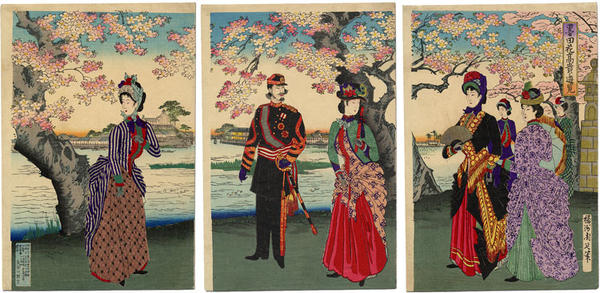Imperialism, particularly during the Meiji period in Japan (1868-1912), brought about profound changes in various aspects of society, including art. Japanese paintings underwent a significant transformation due to encounters with Western cultures and the adoption of Western artistic techniques.
Imperialism introduced Japanese artists to new artistic techniques and styles that revolutionized their approach to painting. The adoption of oil painting, perspective, and realism through the influence of Western art truly impacted Japanese artists. Western-style painting, also known as Yōga, gained popularity as artists sought to incorporate its novel techniques. Yōga contained elements such as the use of oils, watercolors, pastels, and pencils on canvases and was mainly inspired by Impressionist and Post-Impressionist styles. This marked a departure from traditional Japanese painting methods and paved the way for experimentation and innovation.
Under the influence of imperialism, Japanese paintings underwent a shift in subject matter. Traditional themes, such as landscapes, lifestyles, and beliefs, gradually transformed as artists began to explore scenes of modernization, urban landscapes, industrialization, and Western-influenced lifestyles, reflecting the changing society. The integration of Western subjects and concepts challenged traditional notions of Japanese art, expanding the visual vocabulary of Japanese painters. An example of this can be seen through the traditional Japanese attire, like kimonos, and how, with the influence of Western fashion, artists began to depict figures dressed in Western attire, like in the portraits in the series The Meiji Ladies Visit with the Emperor. Western fashion’s depiction differed from traditional clothing representations, adding a sense of modernity to the artworks. This shift expanded the visual vocabulary of Japanese painting, incorporating new forms, silhouettes, and textures into the compositions.
While the influence of imperialism brought about significant changes in Japanese paintings, it also had a profound impact on traditional art forms. Ukiyo-e, a popular art form depicting scenes from everyday life, faced challenges as Western-style prints gained popularity. The demand for traditional craft industries, such as lacquerware and ceramics, declined as mass-produced Western goods flooded the market. The patronage and appreciation of courtly and aristocratic culture diminished, reflecting the shifting social dynamics of imperialism.
In conclusion, imperialism during the Meiji period left an unforgettable mark on Japanese paintings, influencing artists’ techniques, subject matter, and artistic philosophies. The encounter with Western cultures and adoption of Western artistic styles prompted a departure from traditional Japanese art forms and ushered in a period of experimentation and innovation. While imperialism brought challenges and changes to traditional art practices, it also opened new avenues for artistic exploration, shaping Japanese art today. The effects of imperialism on Japanese paintings represent a complex interplay between cultural encounters, style, and the enduring resilience of artistic expression.






Hello dear friend,
your article on Japanese art during imperialism was a great read. Reading about the clash of cultures in Japanese art interesting. Thank you
thanks for sharing!
Thank you for shedding light on the complex relationship between imperialism and Japanese art. Your analysis of how traditional art forms like Ukiyo-e faced challenges amidst the rise of Western-style prints underscores the profound impact of cultural encounters on artistic practices. It’s a thought-provoking exploration of the evolving dynamics of Japanese art during a period of societal upheaval.
It’s always intriguing to learn how artists navigated between traditional and Western influences, resulting in a rich fusion of visual expression.
I can tell you put a lot of work into this… great job
Your exploration of imperialism’s impact is enlightening. It’s fascinating to see how the encounter with Western cultures revolutionized artistic techniques and subject matter in Japanese paintings. The shift from traditional themes to modernization and urban landscapes reflects the changing society and artistic sensibilities of the time